Risk Management Principles
23 Pages4379 Words69 Views
Added on 2020-11-09
Risk Management Principles
Added on 2020-11-09
ShareRelated Documents
Task 1Ans 1 Risk management standards have been planned with the goal that the individuals who must do riskmanagement measures have a guide for help them to work. These standards help to give a globalagreement on the best way to manage certain risks, and they offer best practice guidance on the mostproficient method to manage others. Risk management standards help associations to implementprocedures which are attempted and tried, and proven to work.Ans 2The 11 principlesof AS/NZS ISO 31000: 2009 Risk Management Principles and Guidelinesare:1.Risk management establishes and sustains value.2.Risk management is an integral part of all organizational processes.3.Risk management is part of decision making.4.Risk management explicitly addresses uncertainty.5.Risk management is systematic, structured, and timely.6.Risk management is based on the best available information.7.Risk management is tailored.8.Risk management takes human and cultural factors into account.9.Risk management is transparent and inclusive.10.Risk management is dynamic, iterative, and responsive to change.11.Risk management facilitates continual improvement of the organization.Ans 3WHS legislation according to risk management is for the business methodically oversee risksemerging from work place dangers. Coming up next are the means/cycle to oversee risk:1. identify sensibly predictable dangers - distinguish the conceivable risk that could affect the workersin the company2. eliminate risks by keeping standard risk management3. minimise those risks by recognizing the risk itself and follow the standards1
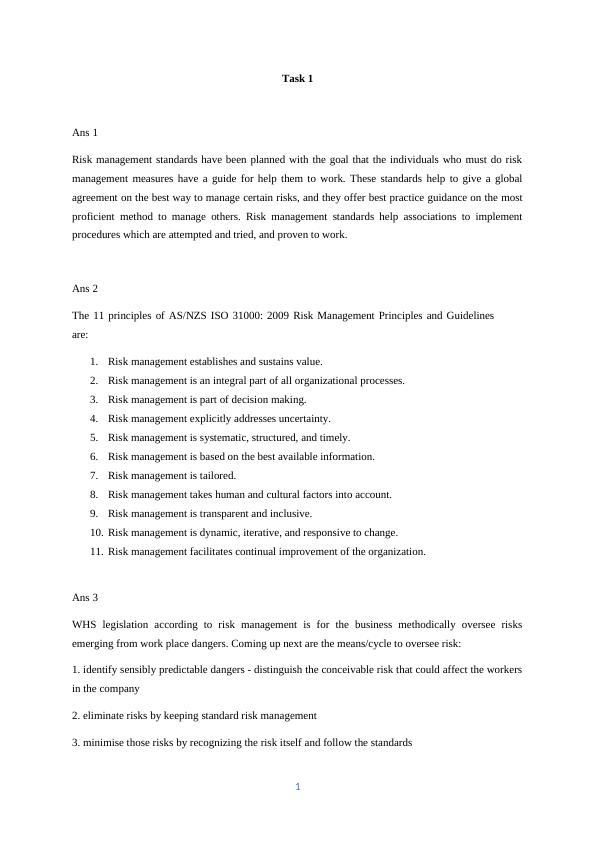
4. implement risk control quantifies so everybody will be in safeAns 4Work Health and Safety Regulations 2011a. postures, movements, forces and vibration relating to the hazardous manual taskb. the duration and frequency of the hazardous manual taskc. workplace environmental conditions that may affect the hazardous manual task or the workerperforming itd. the design of the work areae. the layout of the workplacef. the systems of work usedg. the nature, size, weight or number of persons, animals or things involved in carrying out thehazardous manual task.Ans 5The purpose of risk management policies and procedures in theworkplace is intended to provide aframework for the management of risk and also to increase overall awareness of risk throughout thecouncil and to enable managers and those responsible for risk reporting, to better identify, assess andcontrol risks within their areas.The purpose of risk management policies and procedures in theworkplace are for better decisionmaking, minimize the risk, optimise the outcomes, improve the performance, achieve theorganisational goals, time-saving and cost saving, better understanding for staffs about the riskmanagement in the company.Ans 6The three examples of the impact of risks for a workplace if risks are not identifiedor actioned are:Poor Housekeeping Poor housekeeping rehearses oftentimes add to occurrences. In the event that seeing paper, flotsam andjetsam, mess and spills is acknowledged as would be expected, at that point other more genuine hazards2
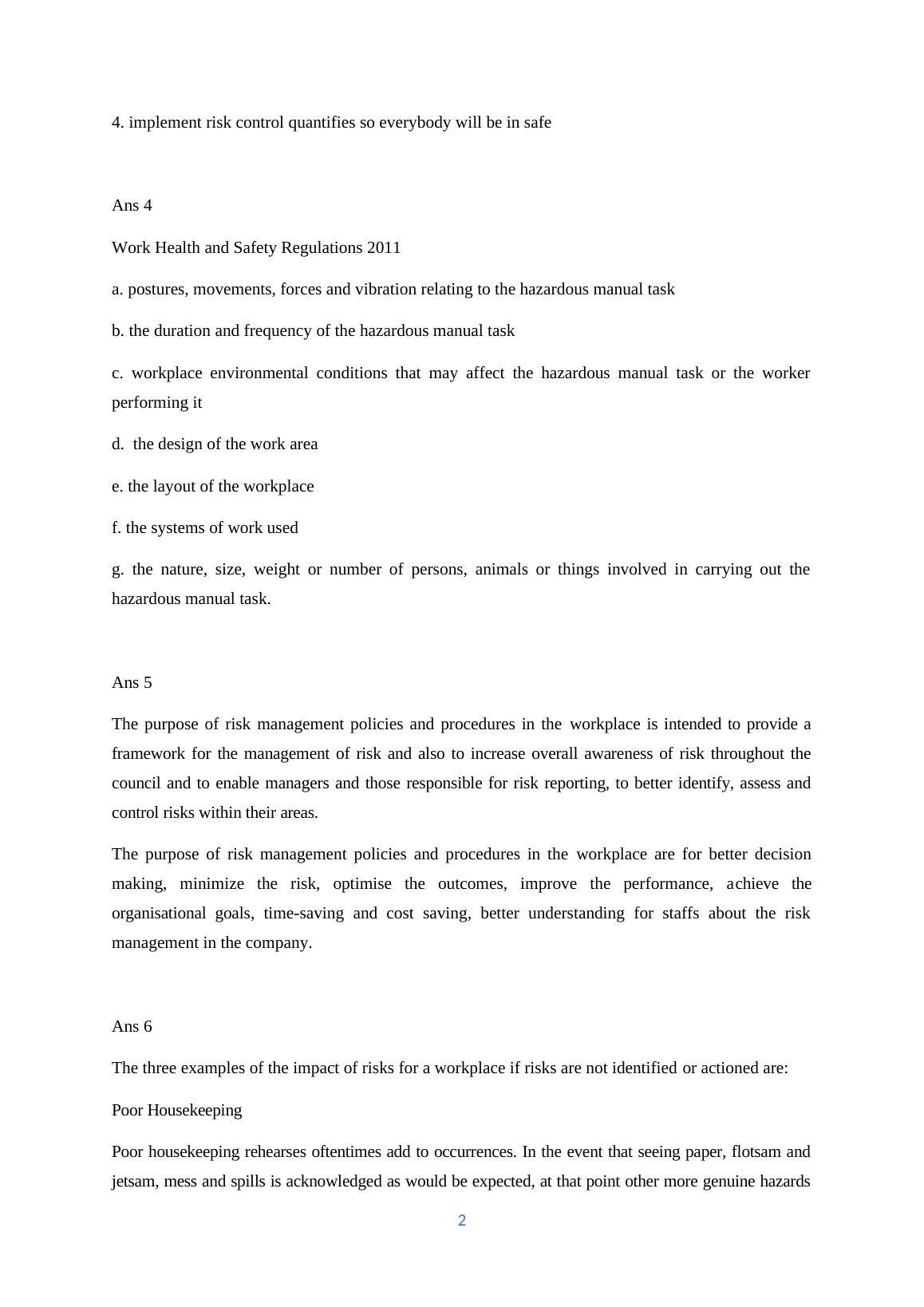
may be taken for allowed. Housekeeping isn't simply neatness. It incorporates keeping work regionsperfect and organized, keeping up corridors and floors liberated from slip and excursion hazards, andeliminating of waste materials (e.g., paper, cardboard) and other fire hazards from work regions. Chemical Hazard Hazardous chemicals are substances that can cause antagonistic wellbeing impacts, for example, harming,breathing issues, skin rashes, hypersensitive responses, unfavourably susceptible sensitisation, malignantgrowth, and other medical issues from introduction. For instance: Paint, Medications, Cleansers, Electrical Hazard Electric shock is one of the most widely recognized hazards across building destinations as per OSHA.Distinguishing electrical hazards can help bring issues to light of the dangers, their seriousness, and howit can hurt laborers.Ans 7The step-by-step procedure that companies can use for analysingrisks are:Step 1: Identify hazards, i.e. anything that may cause harm.Step 2: Decide who may be harmed, and how.Step 3: Assess the risks and take action.Step 4: Make a record of the findings.Step 5: Review the risk assessment.Ans 8The three sources of information that a company could use to gather information on potentialrisks are: Brainstorming Brainstorming is finished with a gathering of individuals who centre around ID of danger for the task. 3
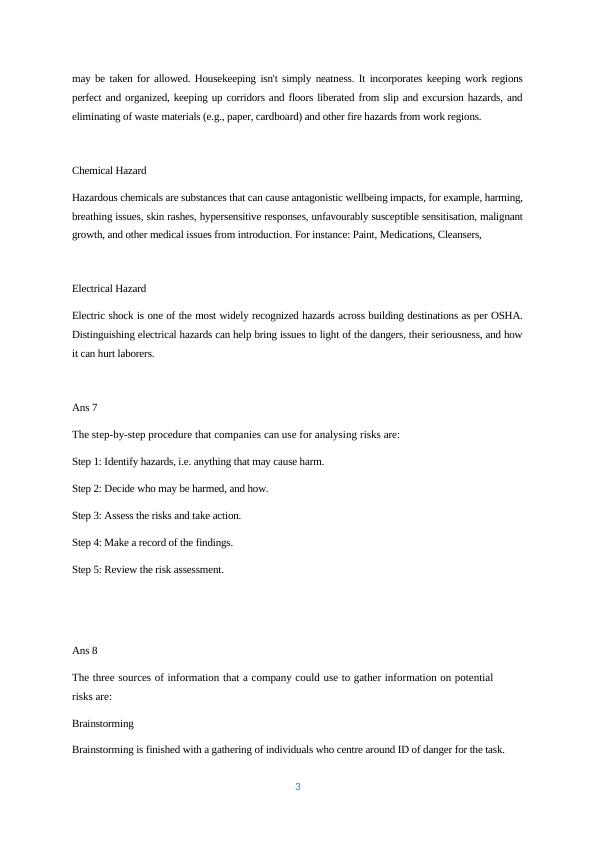
Delphi Technique A group of specialists is counselled namelessly. A rundown of required data is sent to specialists,reactions are gathered, and results are sent back to them for additional consideration until an agreement isreached. Swot Analysis(Strength, Weakness, Opportunities And Threats) Strengths and weaknesses are recognized for the taskand in this way, hazards are resolvedAns 9The three examples of tools or techniques that a company could use to identifyrisks as part of a riskassessmentprocess are: 1. SWOT Analysis STRENGTH, WEAKNESS, OPPORTUNITIES AND THREATS), Strengths andweaknesses are identified for the project and thus, risks are determined.2.Checklist Analysis: The checklist of risk categories is used to come up with additional risks for theproject.3.Risk register: It includes in the historical records that will be used for future projects.Ans 10The four options for controlling risks are:1. PPE: Protect the worker with personal protective equipment.2. Administrative controls: Changing the way that people work.3. Engineering controls: Isolating people from the hazard.4. Substitution: Replace the hazard.Ans 11The four ways to minimise risk are:1. Identification of the risks early in the project.4
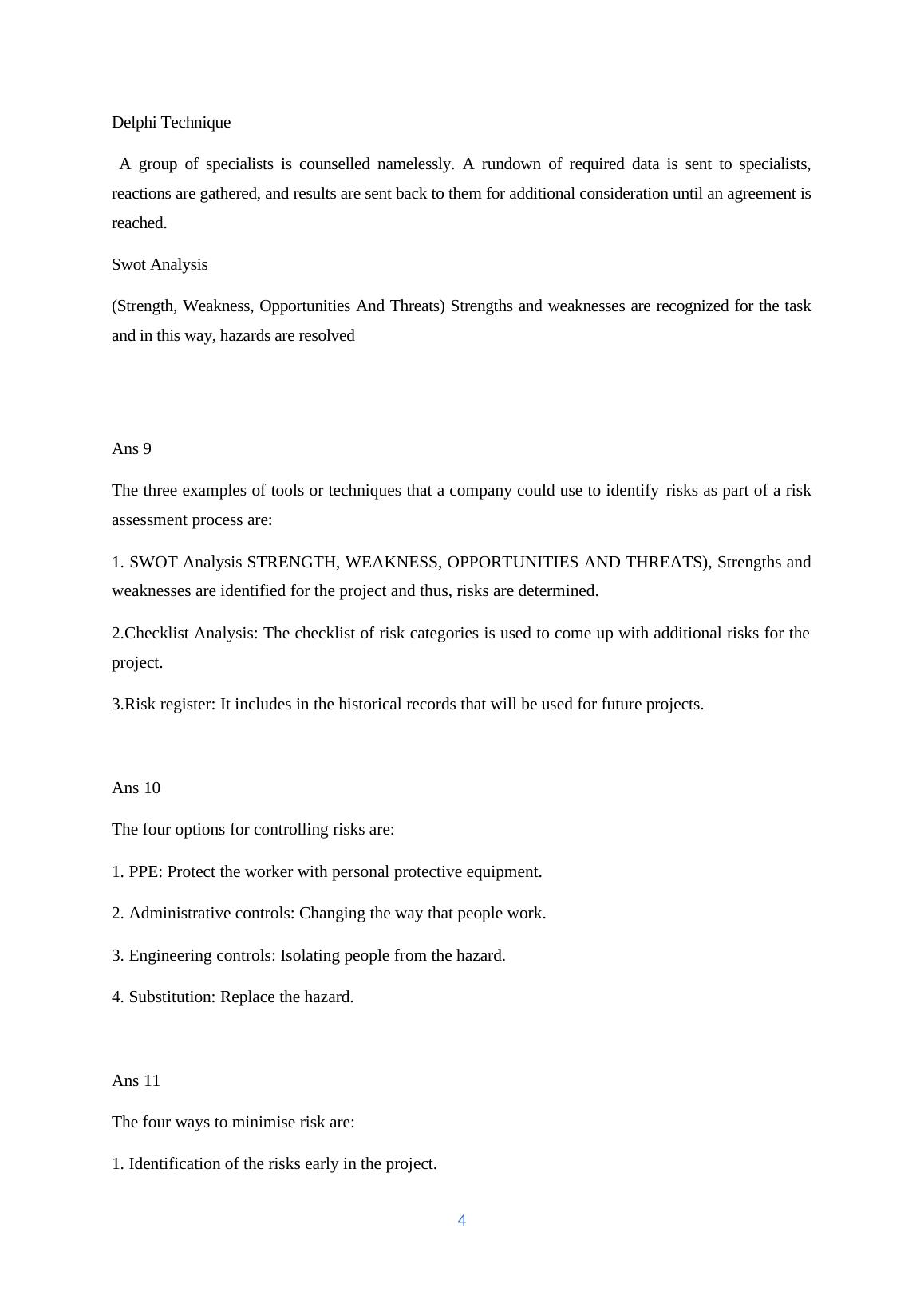
2. Improve communication about risks.3. Consider opportunities as well as threats when assessing risks.4. Prioritizing of risks.Task 2Ans 1Nature Care ProductsRisk Briefing ReportIntroductionNature care is an established organization from 1996 that produces skin care products. The productsthat are being delivered by the organization are eco-friendly and sustainable. The organization createsa wide assortment of common items, for example, cleansing creams, moisturizing creams and facialscrubs. The organization likewise sells its items through its site where its deals are adequate and isanticipating improve the deals in future. The organization is currently monetarily steady however has as of late discovered their rivals sellingsimilar kind of products in the market. Along these lines, the organization chooses to improve itsdeals by in any event 20% in the following three years. In this way, the advertising supervisor isneeded to think of suggestion dependent on his analysis and research.ScopeIncrease the number of people who make a purchase while visiting the online store by 20%.Increase the number of retail outlets selling Nature Care Products by 150.To increase product awareness amongst the target market by 20%.To increase market share to 15%.To expand into at least one international market.To identify new products and new markets.To attain annual growth of at least 10% over the next three years.5
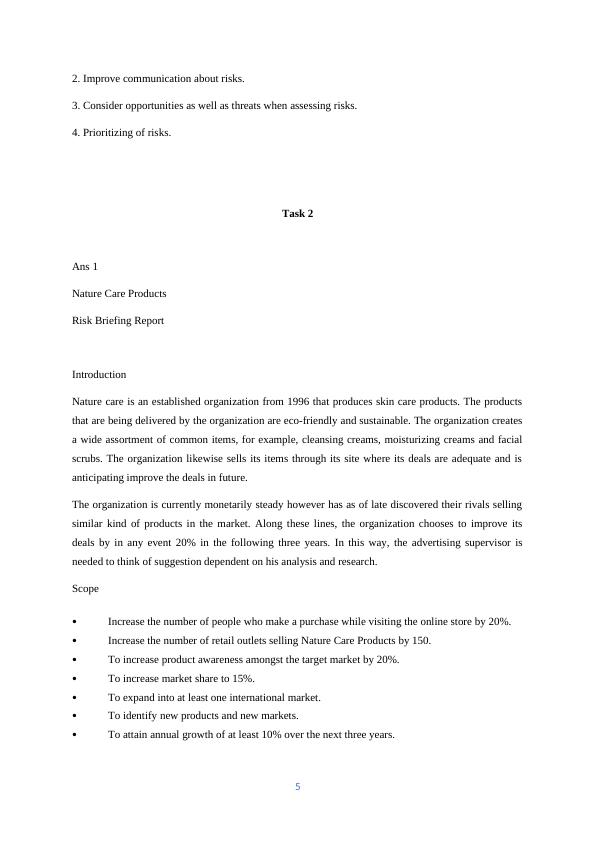
PESTLE AnalysisPoliticalThe political factors include the rules and regulations of the country in which the company is working.The bill presented in 2016 progressively reduces the corporate tax rate from 30% to 25% for allcorporate entities. The recent news polls are indicating another win of Liberal Government whichwould be encouraging for the nature care future investment of $150,000.EconomicalThe economic factors include the exchange rates in the state where the company is working. Australiahas a large economy with a per capita GDP on par compared to other western European countries.Australia has high natural resources and also encourages foreign investments.SocialThe social factors emphasise the technical trends in the society. The modern society is more into theskin care eco-friendly products to maintain their skin with a good hygiene. The company nature careproduces products that are highly sustainable and natural. Based on the view and thinking of today’sgeneration towards the skin care, nature care products have a higher demand comparatively to otherproducts in the market. Mostly the women ageing 25-55 years are likely to be the most interested.TechnologicalTechnology has its own influence in today’s world in all the sectors of life. In a company like naturecare trust and recognition play a major role in the progress and development of the company. Thecompany is always looking forward to develop its products and rather introduce new products to meetthe requirements of the customer and satisfy them accordingly. With the help of technology, it is quiteeasier to develop a good relationship with the customers. Technology provides a basic mean inbetween the company and the customers making it easy for them to access all the newer products andupgraded information of the products. The company’s website is easily accessible by any individualand the technical team of the company always strives forward to keep it up to date with no errors anddefects.EnvironmentalThe environmental factors lead to various global environment safety laws that must abide by theglobal standards. The world has now taken pledge to make the planet beautiful and pollution free.6

End of preview
Want to access all the pages? Upload your documents or become a member.
Related Documents
Desklib - Online Library for Study Material with Solved Assignments, Essays, Dissertationslg...
|5
|1578
|496
Hazard, Safety and Risk Analysis in Work Placelg...
|10
|2648
|33
Complying with Statutory Regulations and Organisational Requirements Assessment 2022lg...
|19
|9135
|114
OWASP Risk Assessment Frameworklg...
|21
|2606
|14
WHS Risk Assessment Formlg...
|7
|1054
|18
Work Health and Safety (WHS) Policy: Overview, Hazard Identification, Risk Assessment, Control Methods, and Referenceslg...
|12
|438
|244
